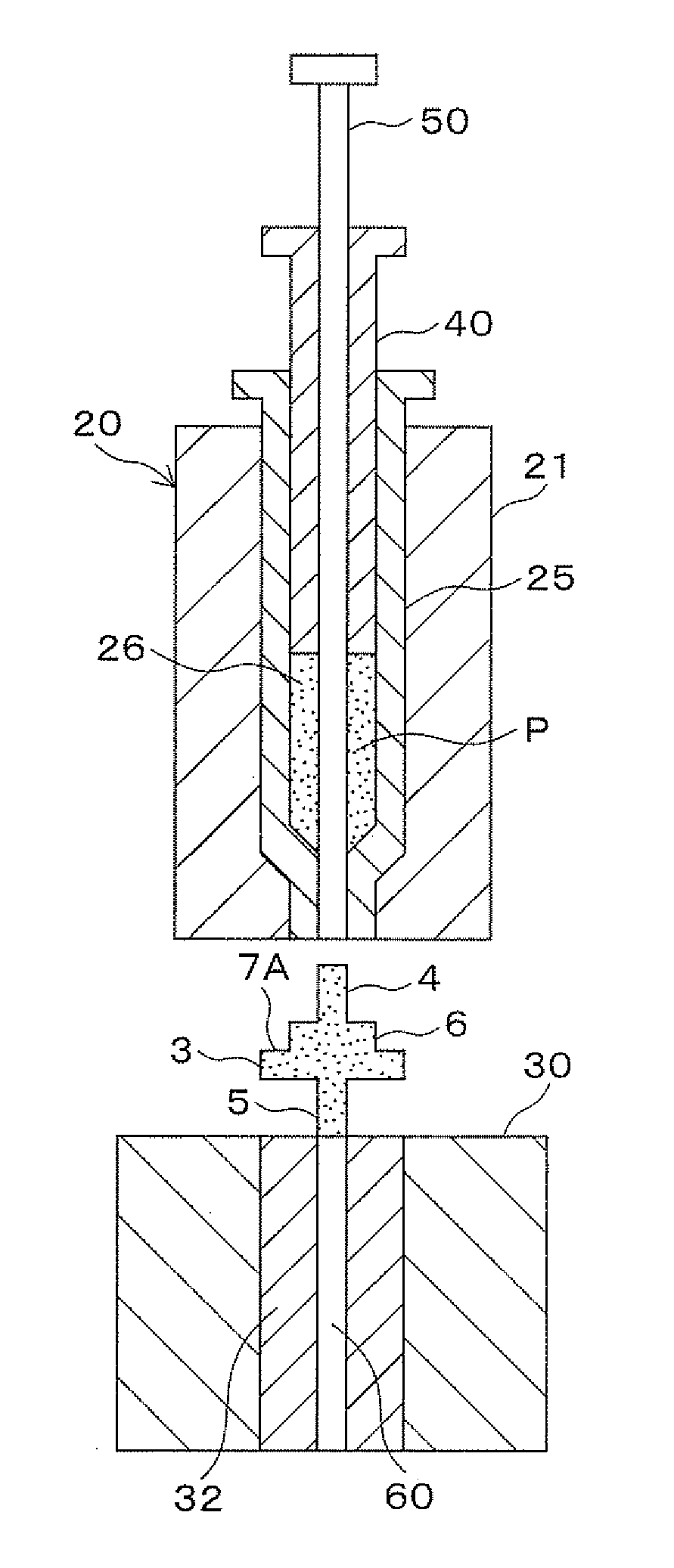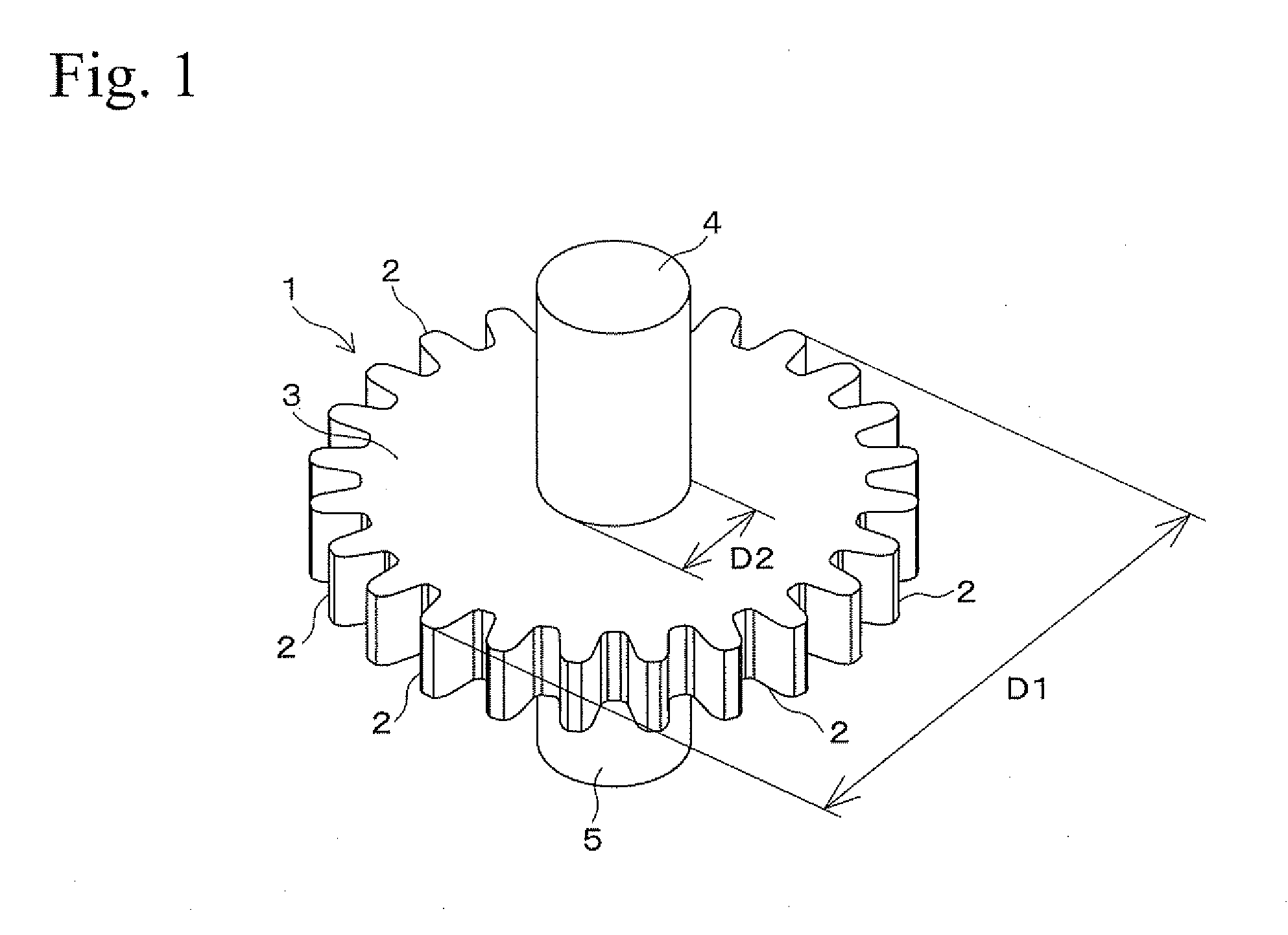Forming die assembly for microcomponents
a micro-component and assembly technology, applied in the field of forming die assembly, can solve the problems of difficult use of raw materials and inefficient production methods, and achieve the effects of improving the flowability of raw materials, easy filling of raw materials, and easy supply of raw materials
- Summary
- Abstract
- Description
- Claims
- Application Information
AI Technical Summary
Benefits of technology
Problems solved by technology
Method used
Image
Examples
first embodiment
1 First Embodiment
1-1 Microgear
[0026]FIG. 1 shows a microgear (hereinafter called a “gear”) of a microcomponent. The gear 1 is obtained by sintering a green compact that is formed by a forming die assembly of a First Embodiment. The gear 1 has a spur wheel portion 3 and columnar shaft portions 4 and 5 which have the same length. The spur wheel portion 3 is formed with plural teeth 2 at the outer circumferential surface thereof. Each of the shaft portions 4 and 5 perpendicularly extends on either side from the center of the spur wheel portion 3. The gear 1 may have the following dimensions. For example, the spur wheel portion 3 has an outer diameter D1 of several hundred micrometers to several millimeters, and the shaft portions 4 and 5 have a diameter D2 of several dozen to several hundred micrometers.
1-2 Forming Die Assembly
(1-2-1) Structure
[0027]FIGS. 2A to 2D and FIGS. 3A to 3D show steps for forming a green compact of the gear 1 by a forming die assembly of a First Embodiment. F...
second embodiment
2 Second Embodiment
2-1 Microgear
[0041]FIG. 5 shows a microgear of a microcomponent. The gear 7 is obtained by sintering a green compact that is formed by a forming die assembly of a Second Embodiment. The gear 7 is a two-step gear in which a spur wheel portion 6 is formed on a side (upper side in FIG. 5) of a spur wheel portion 3. The spur wheel portion 6 has a smaller diameter, and the spur wheel portion 3 has a larger diameter. The spur wheel portion 6 is formed with plural teeth 2 at the outer circumferential surface thereof. The gear 7 also has shaft portions 4 and 5. The shaft portion 4 projects from the spur wheel portion 6, and the shaft portion 5 projects from the spur wheel portion 3. The gear 7 may have the following dimensions. For example, the spur wheel portion 3 has an outer diameter D1 of several hundred micrometers to several millimeters, and the shaft portions 4 and 5 have a diameter D2 of several dozen to several hundred micrometers.
2-2 Forming Die Assembly
(2-2-1) ...
third embodiment
3 Third Embodiment
3-1 Microgear
[0048]The forming die assembly of the Third Embodiment can be also used for forming the green compact of the gear 7 shown in FIG. 5.
3-2 Forming Die Assembly
[0049](3-2-1)
[0050]FIGS. 9A to 9D and FIGS. 10A to 10D show a forming step of a green compact of the gear 7 by the forming die assembly of the Third Embodiment. In the forming die assembly of the Third Embodiment, the cylindrical hole 22 of the outer die 21 of the upper die 20 has a lower end portion. This lower end portion is reduced in the diameter via a tapered portion 22b and is formed with a smaller diameter portion 22c. The inner die 25, which is formed so as to be slidably inserted into the cylindrical hole 22, has a lower end portion. This lower end portion is reduced in the outer diameter via a tapered portion 25b and is formed with a smaller diameter portion 25c so as to correspond to the shape of the lower end portion of the cylindrical hole 22. The smaller diameter portion 25c is formed ...
PUM
| Property | Measurement | Unit |
|---|---|---|
| diameter D2 | aaaaa | aaaaa |
| volume % | aaaaa | aaaaa |
| plasticity | aaaaa | aaaaa |
Abstract
Description
Claims
Application Information
 Login to View More
Login to View More - R&D
- Intellectual Property
- Life Sciences
- Materials
- Tech Scout
- Unparalleled Data Quality
- Higher Quality Content
- 60% Fewer Hallucinations
Browse by: Latest US Patents, China's latest patents, Technical Efficacy Thesaurus, Application Domain, Technology Topic, Popular Technical Reports.
© 2025 PatSnap. All rights reserved.Legal|Privacy policy|Modern Slavery Act Transparency Statement|Sitemap|About US| Contact US: help@patsnap.com



